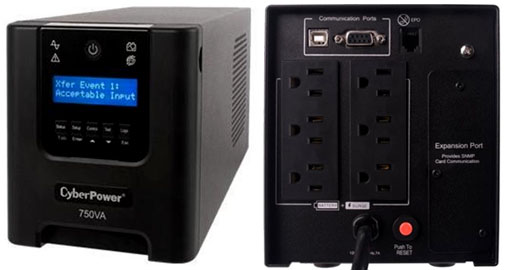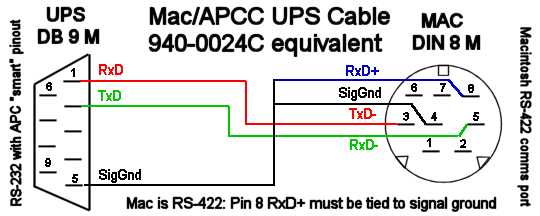Cyberpower Ups Serial Pinout Rs


The CP-USBDB9-BG features a USB port (USB 2.0/USB 1.1 compliant) and a traditional RS-232 serial port with a transfer rate of over 230 Kbps. The 24k gold-plated copper contacts provide excellent conductivity for accurate high-speed transmissions. Modem users select from baud rates of 300-115200 bps. This adapter. Jun 16, 2017. Buy the CyberPower 1000VA Sinewave Series UPS. CyberPower 1000VA Sinewave Series UPS. Grab the CyberPower 1000VA PURE Sinewave Series UPS today! Is APC's smart-signaling cable (940-0024) really proprietary? The documented pinout looks like a. RS-232 serial protocol.
Download Game Yakyuken Special Psx2. We just bought a CyberPower UPS with a serial port. The UPS will not be used to maintain the computer running the LabVIEW program, but is for different equipment.
Hence the standard software for shutting down your computer on a UPS power loss signal is not helpful. What I need is a way to monitor the serial port in LabVIEW so that I can get information from the UPS about its state (AC Power, Battery level, etc.) (This UPS does not support SNMP.) The manufacturer does not supply any documentation about the serial port protocol. I tried installing their software and snooping.
It appears that when their software is installed, nothing is going across the serial port. I'm guessing that their software only monitors some of the handshaking lines. It only reports whether the UPS is on AC power or not and is connected or not. It doesn't report battery levels or any details.
And no traffic is evident on the serial port. Is there a common, known protocol for this type of UPS behavior?
(By the way, I found this old thread: Different brand of UPS, different solution.) Thanks, DaveT. There used to be a white paper on the NI boards. I found the link in other threads, the link seems to have gone dead.
It used a VI to monitor batteries. I wound up adapting a bit for my own purpose to be used as a subVI or as a standalone. I'll attach that here.
I've used it to monitor both a battery in my laptop, and alos APC brand UPS's that had whatever level of drives they came with and a connection to the PC. If the drivers for your battery cause it to show up in Windows Power monitoring, then I hope it can help you. Thanks for the reply. Tempat Download Film 3d Gratis. Crazytalk Animator Pro Templates For Resumes. I do remember the link you mentioned.
I copied that code a while ago and do use it to monitor the battery of the laptop that is running the program. I don't think that will work in this case, since I will eventually need to monitor several UPS's, none of which are dediated to keeping the laptop alive.E.g. I'm assuming that the built-in Windows battery API can only handle one UPS, with the assumption that that UPS is being used for the computer doing the monitoring.
What I really need is the documentation for the low-level protocol that Windows is using to monitor the battery. Then I could implement that protocol directly on the serial ports and monitor as many UPS's as I need to. CyberPower responded to my inquiry with the necessary info. I'll post a brief summary here in case anyone else needs it. They use the handshaking lines to signal UPS state. I think the reason is that they can also drive 'dumb' hardware (relays or whatever) with the same interface. In any case, they use DCD to signal low battery, CTS to signal no AC.
The PC should keep RTS high during communication. DTR can be put high for 7 seconds to tell the UPS to shut down in two minutes. I'm assuming (hoping) that this is a standard interface that a lot of UPS's use. Please post here if you find that it is used by other manufacturers. Cheers, DaveT.
I'm thinking it may be able to handle more than one battery. At least I seem to remember something about my laptop being able to look at its internal battery and an external UPS battery at the same time. I'm not sure if the VI is setup to do that.
Maybe I just saw it in control panel or Windows device manager. If it can handle more than 1, than that would be promising. But I don't know if there is any practical upper limit on the number of batteries it can watch. I'm pretty sure it doesn't have to be a UPS that is dedicated to keeping the laptop or PC alive. A desktop PC doesn't necessarily have to be plugged into the UPS for power even though it might be plugged in for communication. You'd just need to be sure any power monitoring features on a laptop or PC are set to not shutdown when it detects low power levels.
I don't think I can be able to help much more. If you learn anything about the underlying protocol, please report back so we can learn something too.